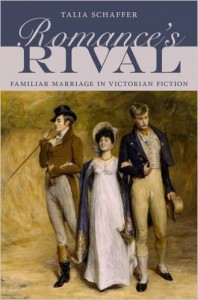 In Romance’s Rival: Familiar Marriage in Victorian Fiction, I argue that the most popular plot of the dominant genre of the nineteenth century – the marriage plot in the Victorian novel – actually functions differently than we had assumed. The marriage plot in fact works to problematize romantic marriage (the new, controversial practice of marrying a person for whom one felt passionate love) by setting it in competition with familiar marriage (the older model of marrying a trustworthy comrade). In weighing two suitors, female characters could essentially decide what kind of life, what kind of person, she wanted to be. Romantic marriage offered the chance to be a modern individual; familiar marriage, however, confirmed her enmeshment in relational values. Romance’s Rivals addresses the history of the novel from Clarissa through Howard’s End, focusing primarily on Austen, the Brontës, Trollope, Yonge, Craik, and Broughton. Covering hundreds of novels over centuries, Romance’s Rival aims to rethink the history of female subjectivity through the crucial mechanism of the marriage plot.
In Romance’s Rival: Familiar Marriage in Victorian Fiction, I argue that the most popular plot of the dominant genre of the nineteenth century – the marriage plot in the Victorian novel – actually functions differently than we had assumed. The marriage plot in fact works to problematize romantic marriage (the new, controversial practice of marrying a person for whom one felt passionate love) by setting it in competition with familiar marriage (the older model of marrying a trustworthy comrade). In weighing two suitors, female characters could essentially decide what kind of life, what kind of person, she wanted to be. Romantic marriage offered the chance to be a modern individual; familiar marriage, however, confirmed her enmeshment in relational values. Romance’s Rivals addresses the history of the novel from Clarissa through Howard’s End, focusing primarily on Austen, the Brontës, Trollope, Yonge, Craik, and Broughton. Covering hundreds of novels over centuries, Romance’s Rival aims to rethink the history of female subjectivity through the crucial mechanism of the marriage plot.
Winner: NAVSA Prize for Best Book of 2016
Selected for Choice Outstanding Academic Books of 2016: ChoiceOutstandingTitles
Reviews:
Heather Hinds, The Wilkie Collins Journal 15 (2018)
Emily Allen, Nineteenth-Century Literature
Jill Rappoport, Nineteenth-Century Contexts
Claudia Nelson, Victorian Studies
Annette Federico, English Literature in Transition
Clare Walker Gore, Journal of Victorian Culture
Lauren Hoffer, Studies in the Novel
Sarah Kniesler, Nineteenth-Century Gender Studies
Jolene Zigarovich, Women’s Studies

